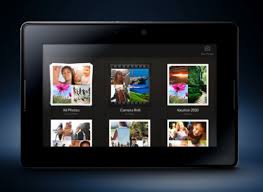Last year was the year of the 3D TV. This year is the year of the tablet PC. When looking through my various tech and gadget
blogs on
Google Reader, most of what I saw was either stupid, or tablet, or both. At the recent
Consumer Electronics Show, pretty much every PC manufacturer announced a tablet PC.
For those slightly unfamiliar to the technology world, a tablet is a touchscreen computer that usually runs a mobile operating system. Some run the popular
Android, others their own customized OS, some run
Windows 7, and a few even run
Linux.
The tablet PC was started by Microsoft quite a few years ago, but the concept never caught on. Until now.
Apple's iPad really popularized the idea of the tablet. Now
Motorola,
Samsung, and even
Vizio, a TV manufacturer, have caught on.
In September,
RIM (The creators of
Blackberry.) announced it's
PlayBook, a 7 inch tablet running a new, personalized OS. The BlackBerry tablet was always a cool idea, but nobody was ever really able to touch it. Until now. (Second time I've used that this post.)
 |
| BlackBerry PlayBook |
At the Consumer Electronics Show, BlackBerry had a few working prototype models displayed. Viewers can see a tech demo, and the lucky few could actually play with the tablet. The reviews were overall good all around, and although it is not a final model, the device seemed to work fairly well.
The PlayBook is 7.6 inches across, 5.1 inches in height, and only 0.4 inches thick. With a weight of 0.9 pounds, the PlayBook is lighter than the 1.5 pound iPad by about 0.6 pounds, and with it's small size and light weight, the PlayBook will be great for professionals on the go.
The PlayBook does not run the BlackBerry software, but, simular to the BlackBerry smartphone lines, is optimized for business use. Unlike most tablet PCs, the PlayBook has true multitasking, meaning that, unlike other tablets, it does not pause apps when they are minimized. Rather, this BlackBerry tablet leaves apps running completely, and lets you see them running with it's unique user interface.
 |
| PlayBook's Photo App |
The PlayBook features a 7 inch capacitive touch screen, a 3 mega pixel front facing camera for video chat, along with a 5 mega pixel rear facing camera for (the strange few) who want to take photos with a 7.6 inch tablet, and a microUSB and microHDMI port. The PlayBook also sports stereo speakers and 1080p video playback.
The business user needs power, and BlackBerry promises power with the PlayBook with a 1GHz processor and 1GB of RAM.
The coolest parts of the BlackBerry PlayBook are the little things. The fact that there are no physical buttons on the front, and that the touchscreen extends beyond the visible screen, so you just swipe up from the bottom to access the home screen. Another neat feature is the actual home screen. The bottom half contains a grid of your apps, while the top half contains small previews of the currently running apps, as they are running. For example, a running YouTube video would be watchable (in a very small window) even when you are not currently in that app.
The PlayBook has 3G or 4G, along with 802.11 a/b/g/n WiFi, and Bluetooth 2.1+ EDR. The 4G will be available from
Sprint, and with the 3G version, it is not clear which carriers will have it.
The PlayBook seems like a very compelling device. Two things may stand in the way: The price is still unknown, and with all of the true multitasking going on, it will be hard for BlackBerry to achieve good battery life.
The BlackBerry website states, "BlackBerry 4G PlayBook coming soon to Sprint." This seems to indicate a near release date, so PlayBook awaiting individuals, the seven inch tablet of your dreams may be coming out sooner than you think. If you were planning on purchasing an iPad, but like the PlayBook, you might wan't to wait for it. The only reason I'm not saying "Buy it." is because it is not yet buy-able. But if it were, I would definitely recommend the BlackBerry PlayBook.















